Alocasia is a gorgeous tropical plant that can transform your living room into a small private jungle. Even just one tiny plant, perhaps carefully placed in a particular corner of the house, is enough to recreate the scenario of lush native vegetation. There are over 100 species of alocasia in the world, but in this article we’ll take a closer look at 19 stunning types of alocasia.
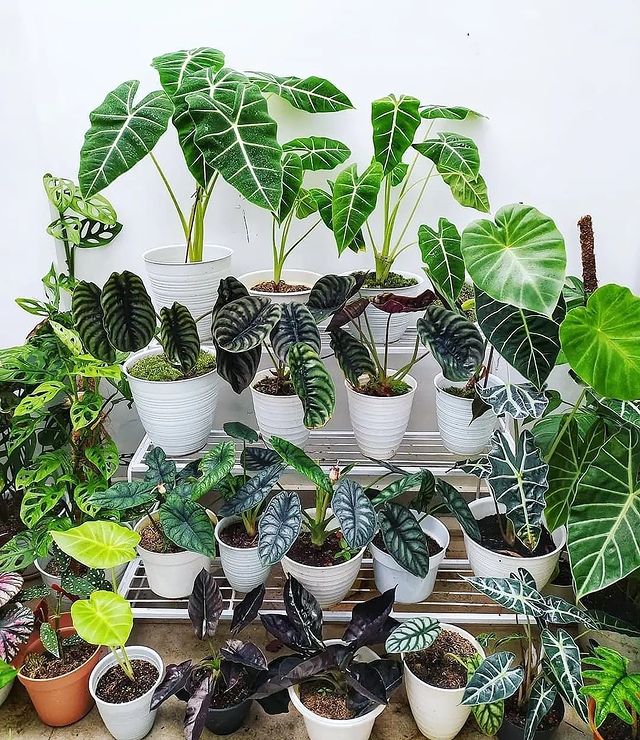
What is Alocasia?
The genus Alocasia, from the Araceae family, includes species native to the tropics of Southeast Asia and eastern Australia.
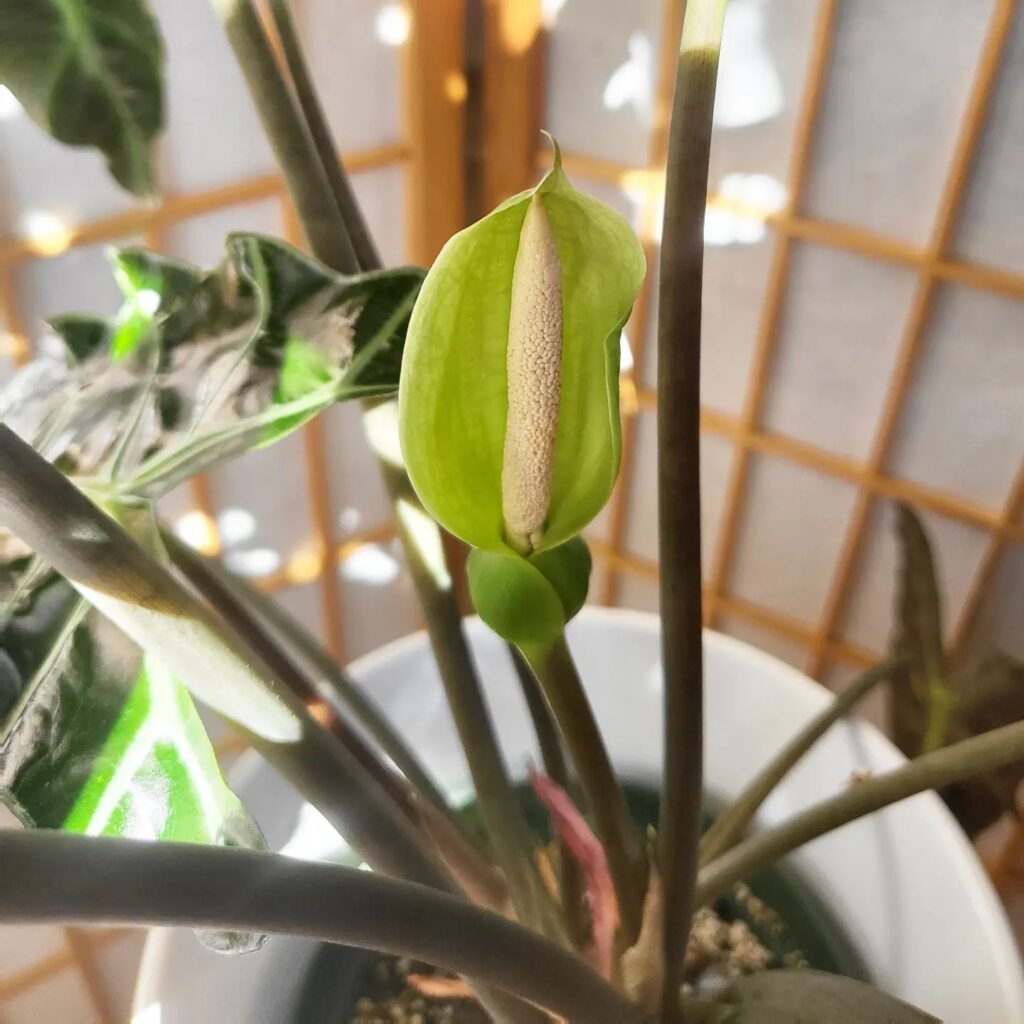
Although they are blooming plants, their flowers are not particularly interesting since they have a pistils-like appearance and light green spathe.
Yet their colorful and large leaves make them one of the most popular ornamental indoor plants worldwide. These ornamental plants grow from a thickened tuberous root in which they deposit water and nutrients.
The plant has an upright growing habit and famous elongated heart-shaped leaves with wavy edges and pronounced veins growing on tall, erect stems.
The genus includes about 100 species that vary in size. Indoor Alocasia plants’ size depends on the variety, but they usually grow between two and six feet in height and slightly less in width. Nonetheless, in nature, some species can grow up to 15 feet.
General Care Instructions
Even though the Alocasia genus encompasses many species, general care requirements are very similar. However, one might note that when it comes to taking care of these gorgeous plants, one-size-fits-all cannot be applied and may vary in certain needs.
Soil
All Alocasia plants thrive in any potting mix well-drained with chunks of perlite, vermiculite or orchid bark. Using a good aroid mix will prevent root rot, which is a common problem with these plants as they do not cope well with excess water.
Repotting
When it comes to repotting, these exotic divas prefer to be rootbound, so frequent pot changing is not something they desire, especially in the beginning. Repot your Alocasia plant every 12-18 months with a bank one to two inches larger than the previous one.
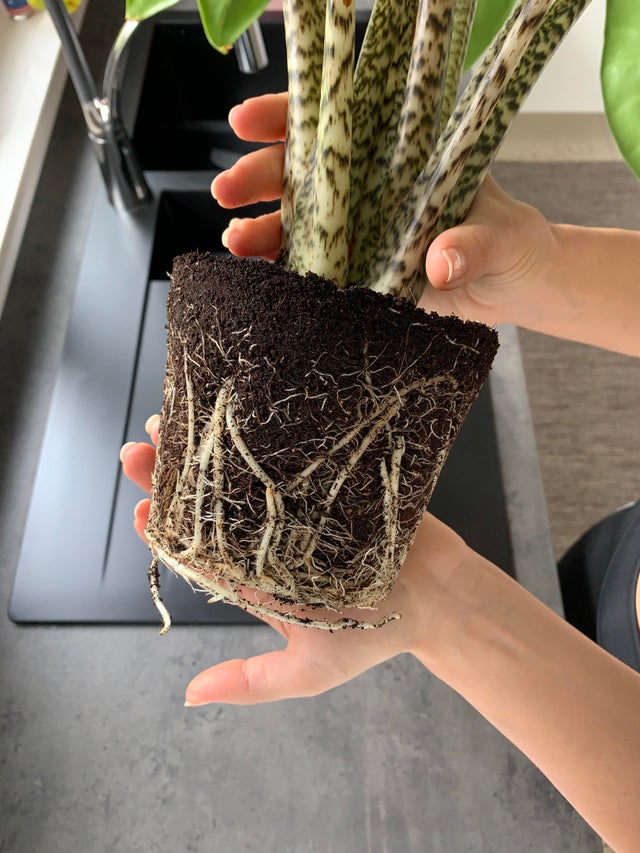
Repotting can also vary depending on the size of your Alocasia plant. It would help if you repotted mature Alocasia plants every 18-24 months. These ravish plants are the strongest in spring and summer, making them ideal for repotting.
Watering
The easiest way to kill your Alocasia is by overwatering it, so when it comes to watering these plants, the best rule is – less is more. However, remember that it does not mean that they prefer prolonged periods of dry soil as this can also be very detrimental to their health.
The best way to ensure that you provide the optimal amount of water is to feel the soil with your fingers. If the top couple of inches is dry, that is the time to water.
On the other hand, if the soil is moist, wait a couple of days until it dries out as they enjoy drying out between watering. During the autumn and winter, reduce your watering regime because most plants enter their dormant phase.
To sum up, you should always keep the soil moist but never soggy or too damp!
Light
Alocasia generally prefers bright indirect light, while direct sunlight will cause the burning of its leaves. The amount of light the plant receives dictates its growth, so if you wish to push out new leaves, place your plant in a spot with a lot of indirect sunlight. If you relocate your plant outside, make sure the site receives partial shade.
Temperature
As a plant originating from tropical and subtropical Asia, Alocasia thrives in climates that emulate their native environment-rainforests. Consequently, the optimal room temperature is above 60 F.
However, it is essential to note that Alocasia plants are susceptible to low temperatures, and most of its varieties do not tolerate temperatures under 50 F.
Avoid placing your Alocasia near a drafty window or in front of a heating fan, as they are easily affected by temperature fluctuations which can inhibit their growth and cause leaf damage.
Humidity
Considering their subtropical origins, these plants thrive in moisture, so make sure they receive lots of humidity. If you live in drier climates, you can make up for the moisture using a humidifier or a pebble tray with water to ensure that your plant receives the optimal dampness level.
Fertilizer
Whether you should use fertilizer largely depends on the Types Of Alocasia. While the smaller Alocasia plants require fewer nutrients and energy, you can skip fertilizing from time to time.
On the other hand, mature Alocasia can benefit from fertilizer since their roots supply a larger leaf mass and need additional nutrients.
When the plants are actively growing, summer and spring, you can add a little boost to your gorgeous indoor Alocasia, pushing out new growth. Avoid using fertilizer during its dormant phase, in autumn and winter.
List of the 19 Most Popular Types of Alocasia
The stunning realm of fascinating Alocasia includes dozens of plant varieties, hybrids, and cultivars. We have singled out the 19 most popular plants easily found in the standard market offer. After that, it’s up to you to choose the one or ones that best fit your ambiance!
1. Alocasia Cucullata “Hooded Dwarf”
Alocasia Cucullata “Hooded Dwarf” is one of the smallest varieties called the Chinese Tarot. Due to its unique size, Hooded Dwarf Alocasia is very different from other Types Of Alocasia considering it rarely exceeds three feet in height.

Small deep green leaves, which resemble tiny elephant ears, have thick veins on the underside. They are light green and with inverted margins.
Commonly known as the Buddha’s Hand, Alocasia cucullata is typical among Thailand residents who tend to place it in front of their house’s entrance. The reason is simple – it is because when the wind blows, the leaves of Alocasia Cucullata sway gently, almost as if the Buddha’s hands are moving, greeting, and wishing good luck to those who will soon enter the house.
2. Alocasia Amazonica Polly
Alocasia x amazonica is the arguably most popular and sought-after alocasia variety. It is a hybrid obtained by crossing Alocasia Longiloba and Alocasia Sanderiana, which can be grown in pots or even directly in the garden.
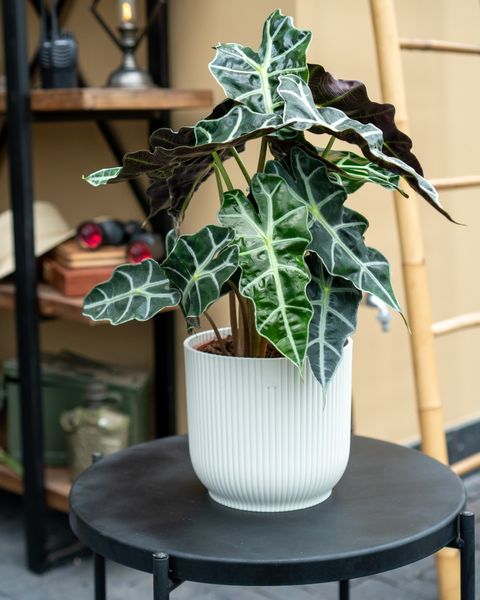
Do not let its name, Alocasia Amazonica Polly, confuse you since the plant has nothing to do with Amazon – it bears the title after the location of Amazon Nursery in Miami, Florida – the origin of the cultivar.
RELATED: How To Care For Alocasia Polly? All the Questions and Answers You Need
The leaves of Alocasia Polly are exceedingly large and arrow-shaped: they can reach 20 inches in length and about ten inches wide. They are dark green and have very bright white (or creamy) veins. The off-white edges gracefully frame the leaf blade.
3. Alocasia Lauterbachiana – The Purple Sword
The purple sword resembles a cold weapon waiting to fight. Narrow leaves in the shape of serrated oriental blades make the plant a unique sight in the world of Alocasia plants.
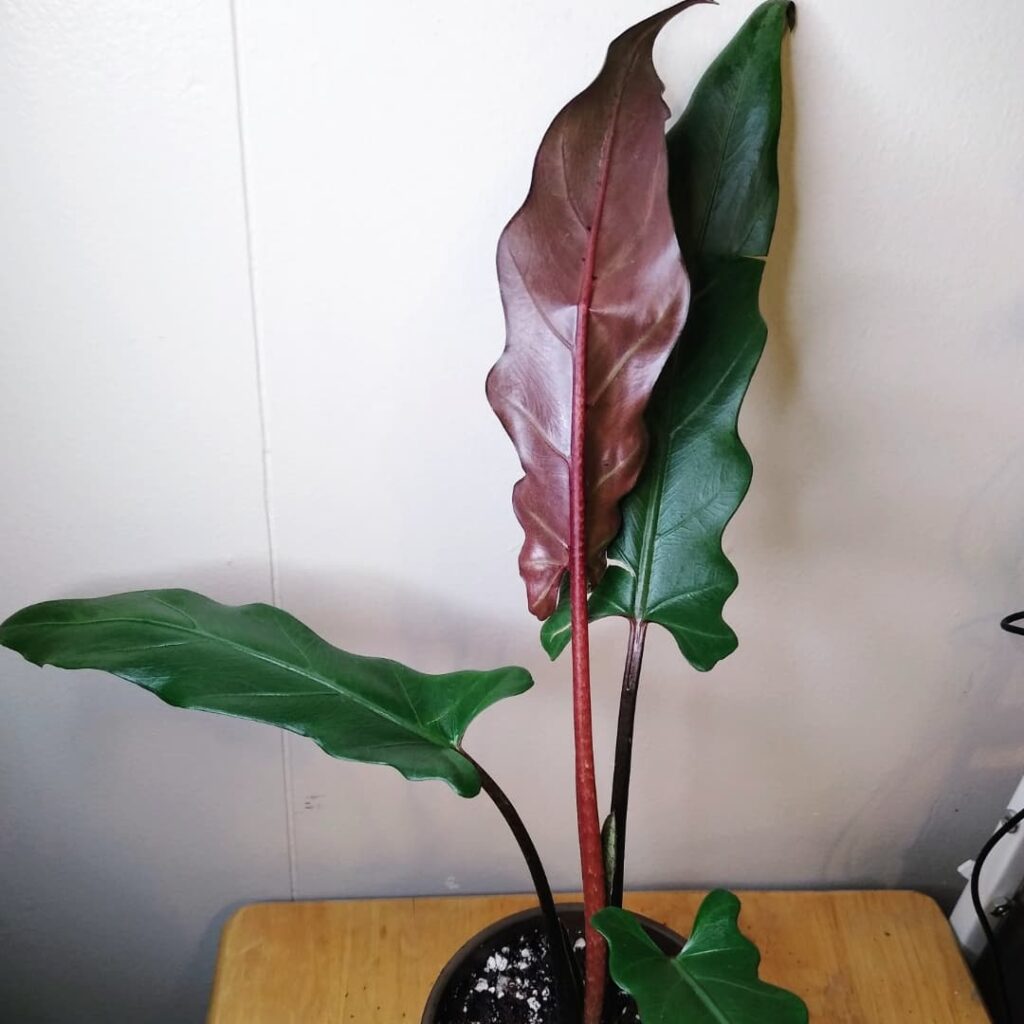
Graceful, elongated leaves with dark green shade and elegant colorful patterns grow on the purple or violet stem, which explains its name.
Sword-like leaves stand vertically, showing purple-colored veins in the center and the leaf’s underside.
This variety of Alocasia is an excellent solitary plant. But since it grows up to 47 inches, you can place it among smaller greenhouse plants to highlight its unique color.
4. Alocasia Wentii
Alocasia Wentii flourishes at temperatures between 64-72 F. These relatively large alocasia varieties attract attention with the size and stunning colorful leaves. Alocasia of this species can grow to a height of five feet, indicating that this plant needs a spacious area to thrive.
RELATED: Alocasia wentii: The #1 Care, Watering, and Propagation Guide
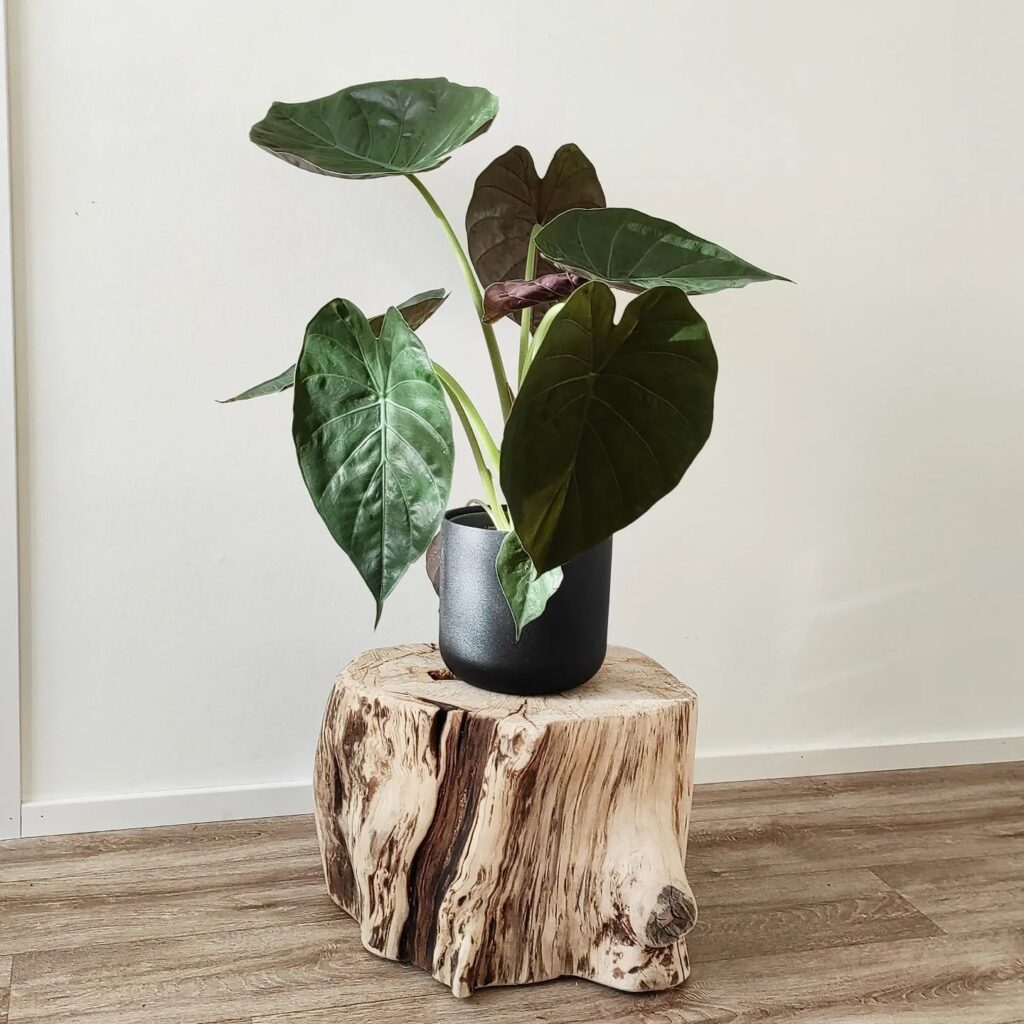
Also known as Hardy Elephant Ears, Alocasia Wentii has heart-shaped shiny green leaves with a purple undertone.
To make Alocasia Wentii look the most favorable and decorative, you should put the plant in a bright place, protected from direct sunlight, because the amount of light that a plant receives directly affects the color intensity of its leaves.
5. Alocasia Micholizziana “Frydek”
Alocasia Micholitziana “Frydek“, also known as Green Velvet Alocasia, is a relatively large plant that belongs to the African mask alocasia variety. This plant comes from the Philippines and has become a sought-after and popular houseplant in the last few years.
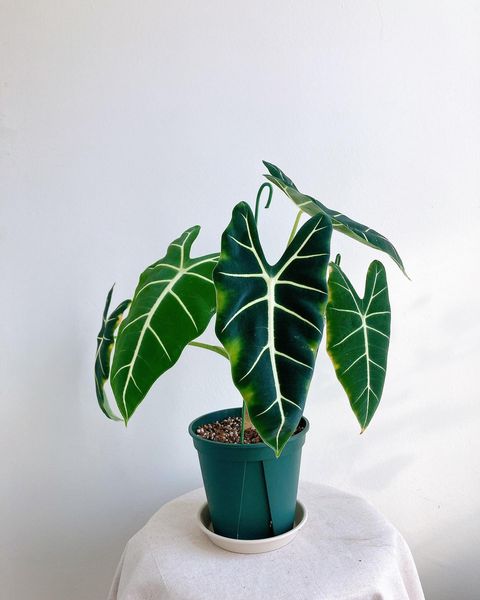
The two-feet long, velvety, dark green leaf blades, with an emerald, bright green hue, have pronounced thick, white veins and slightly wavy edges.
Alocasia Micholitziana has a moderate growth rate in optimal conditions and reaches its full size of two to three feet in two or three years.
Frydek alocasia produces topical slightly fragrant pistil-like flowers with a white-green bract. Yet, the flowers do not have a pronounced decorative effect.
6. Alocasia Macrorrhiza “Stingray”
It is not difficult to distinguish Alocasia Macrorrhiza “Stingray” from other types because it has very characteristic leaves. Namely, the leaf is broad, resembling wings but has an extension similar to a tail or a sting, after which it got its name.

In addition, large, bright green leaves grow on dark stems, which further emphasizes the decorativeness of the plant.
Alocasia Stingray is a fast-growing species that comes from the humid forests of southern Asia. In nature, it grows up to 15 feet in height and eight feet in width, but indoors it is a plant of much more modest dimensions and rarely grows more than four feet.
Due to its unusual exotic appearance, the plant might look tricky, but the truth is quite the opposite! With a proper watering regime (once a week), indirect lighting and average room temperature, this plant will be pretty satisfied and thrive nicely in your home.
7. Alocasia Macrorrhiza “Giant Taro”
Alocasia Macrorrhiza is one of the most widespread Types Of Alocasia and, even if the dimensions are very different, has aesthetic characteristics similar to dwarf bananas.
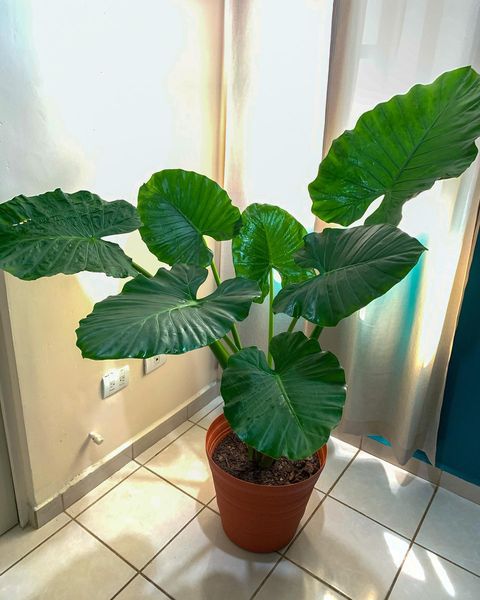
Giant taro is truly a spectacular plant, with fleshy stems and large heart-shaped leaves that can easily exceed 10 inches. The leaves are usually light green, while some specimens of Alocasia macrorrhiza can develop darker or even purple leaves. Yet, darker-colored varieties are pretty rare.
Like most alocasia plants, Giant taro is a flowering plant as well. However, the harmonious shape of its beautiful leaves has an advantage over the rather inconspicuous Kala-like flower with a mild scent. In other words, its decorative leaves make it a spectacular plant with or without flowers.
8. Alocasia Cuprea “Red Secret”
Alocasia cuprea does not look like an ordinary plant! Instead, it looks like a real work of art made by a skilled bronze master. The large leaves, up to 27 inches long, are so perfectly shaped that they look like long forging.

The species is native to Borneo and has exceptionally colored dark green leaves with coppery shine. Alocasia cuprea is known as Mirror Plant due to its metallic-like gloss foliage.
The peculiarity is that it seems to change color when looking at the plant from different angles – truly fascinating chromatic games.
Despite its size, it leaves a strong impression as a focal point in any place.
9. Alocasia Baginda “Silver Dragon”
Alocasia baginda “Silver Dragon” is a popular houseplant with attractive silvery green leaves of striking contrasts and pronounced texture. It is native to the tropical forests of Borneo.
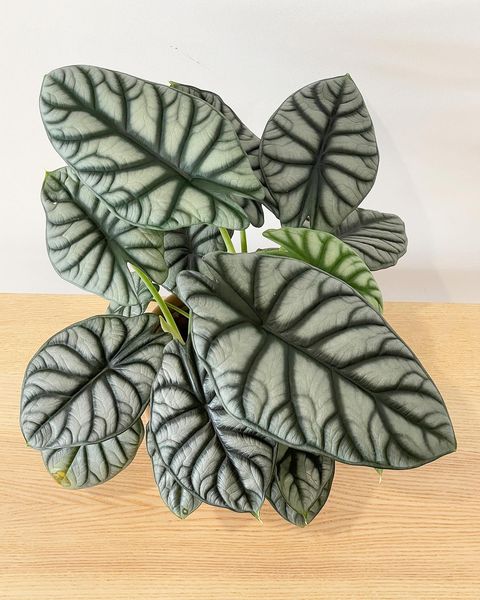
Its leaves have a slightly elongated heart with a pronounced tip. The leaf blade has silvery reflection beautifully contrasted with dark green primary veins. The unusual combination of colors places Alocasia baginda on the top of the must-have plant list for every plant lover.
However, the Alocasia Silver dragon is not the only Alocasia with silvery-green foliage! A very similar plant is Alocasia reversa, so even an experienced plant lover finds it challenging to distinguish them.
The main difference is that Alocasia reversa along the central vein has a wider dark green pigmented area and slightly elongated leaves. In other words, Alocasia baginda has lighter leaves due to the dominance of silver tone.
10. Alocasia Baginda “Dragon Scale”
Alocasia baginda “Dragon scale” has a fantastic texture with veins that can be imaginatively reminiscent of dragon shells. The leaves play their distinct role – they are firm and flexible and even have a hardened upper side. This variety, which originates from the tropical forests of Borneo, is one of the most beautiful gems of the alocasia genus.
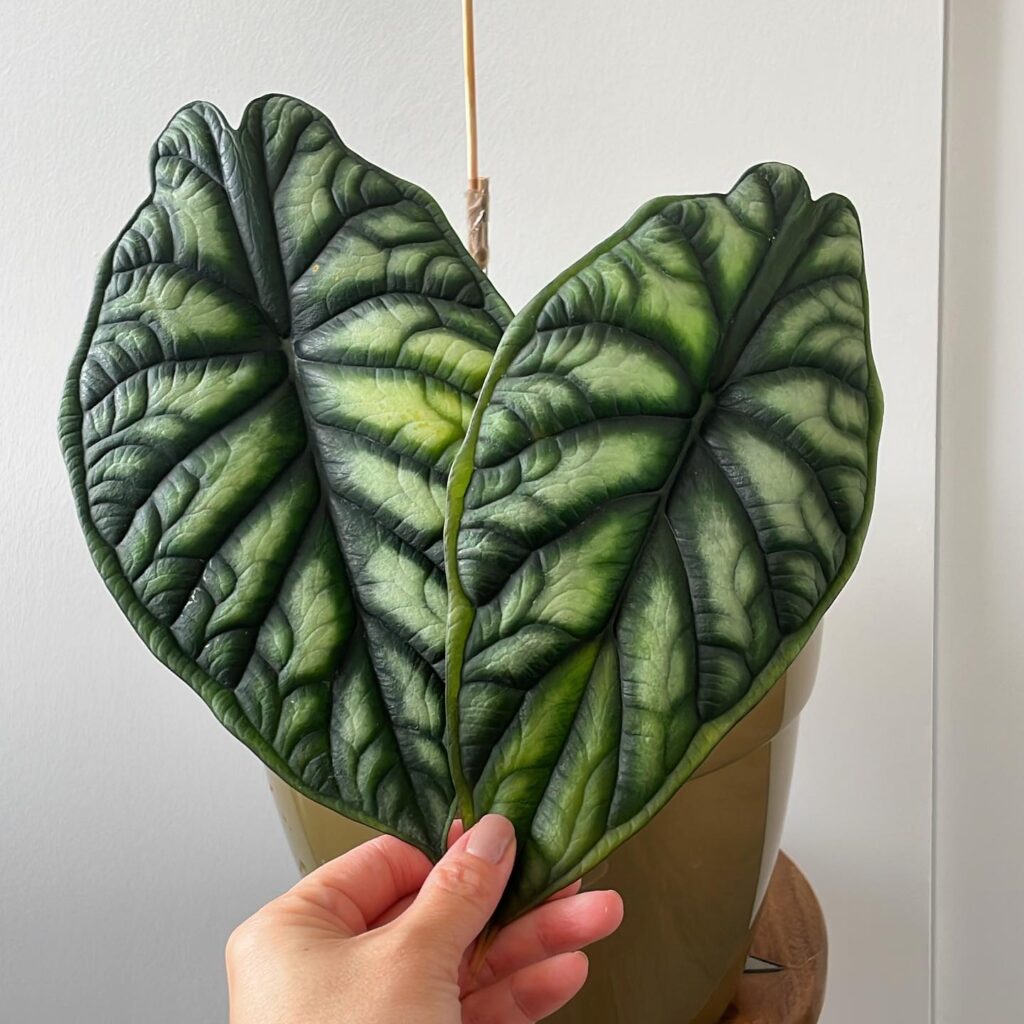
The silver-green leaves of Alocasia Dragon Scale are deep green towards the middle, giving a lighter shade a milder tone. The undersides are pale stony with vivid chestnut veins. The color on the young leaves deepens with maturity.
Dragon scale alocasia is striking in any size and stands alone or is in pleasant contrast with other plants.
Dragon Scale Alocasia prefers narrow spaces, making it a perfect candidate for a terrarium.
11. Alocasia Sanderiana (Kris Plant)
Alocasia Sanderiana is similar in size and has many external features to other Types Of Alocasia. Still, the 11 to 15 inches long leaves are not only in the shape of an arrow but also decorated with bizarre notches. Therefore, the leaves are more reminiscent of an ancient spear or halberd.

Alocasia Sanderiana, once found in the highlands of the Philippines, is today a desirable indoor plant and inspires growers to develop interesting interspecific hybrids.
Large thick metallic leaves and bright colors – the essential characteristics of species belonging to this genus do not change, but each has a detail that makes it unique.
The Sanderiana species has dark green arrow-shaped leaves, on which metallic-colored ribs and chromatic reflections are visible, creating amazing games of light. It is best to grow this plant indoors, and when it moves outdoors, it is useful to place it in sheltered places.
12. Alocasia Zebrina
If you wonder why a plant with large monochromatic leaves is called a zebra, the answer is simple: the epithet zebra does not refer to a leaf but to a stem with pronounced white-green stripes in a zebra pattern. Alocasia zebrina comes from Southeast Asia, but it is a pretty rare plant, and you cannot see it often in its natural habitat.

Moreover, it is rare as a houseplant. One of the reasons is that it is more demanding than other alocasia plants and is much more challenging to adapt to standard indoor conditions. In addition, like a true drama queen, it reacts heavily to inadequate humidity and is sensitive to temperature fluctuations.
However, do not let that discourage you! If you come across this plant by any chance, give it a shot, taking care of its specific needs. Alocasia zebrina will thrive like any other Alocasia if given the appropriate surroundings and conditions.
13. Alocasia Longiloba Lowii
This types of Alocasia, also known as Lowii, inhabit the shady underground of the humid jungle in subtropical Asia.
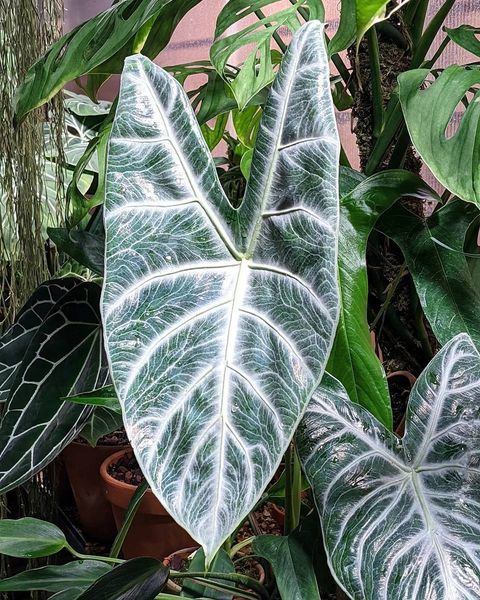
The plant rarely grows more than 39 inches, and in nature, they thrive on rocky slopes with a small layer of soil. The aerial part of the Alocasia consists of creeping stems and large narrow leaves.
The upper side of the leaf blade, up to 10–12 inches long, is green with a blue or bluish tinge. The back is purple or purple-green – against such a background, strong silver-gray or whitish primary and secondary veins stand out nicely.
The loose leaves of Alocasia Lowii or longiloba, as this species is called today, adhere to the understanding that cylindrical petioles have the shape of a sagittal spear. The stalks of Alocasia Lowii are brown or green, with a dark brown stripe-like pattern in the form of stripes.
Although it rarely blooms indoors, it still can happen that the flower, wrapped in greenish covers, appears on a stalk three to 7 inches long. After pollination, almost spherical dark orange berries up to 0,2 inches in diameter ripen at the place of flowering.
14. Alocasia Melo Rugosa
Also known as Jewel Alocasia, Alocasia Melo has distinctive creeping thick stems and heart-shaped leaves. Its thick flat leaves of gray-green hue resemble the skin of an ancient animal or a plastic product.

The surface of the leaf blade is uneven, small tuberous, while the veins are pressed, darkened. Young leaves are lighter than mature leaves and much softer to the touch. As a terrestrial plant, Alocasia Melo spreads by forming a short scrub-like structure.
Like most Types Of Alocasia, Alocasia Rugosa has Anthurium-like flowers that rarely exceed the number of three flowers simultaneously. The flowers are non-fragrant and egg-shell white.
15. Alocasia Fallax
Botanists consider Alocasia fallax, a possible ancestor of the famous Alocasia odora. The height of this large plant can reach eight feet meters. If you cut its leaf, the whitish milky juice is released.
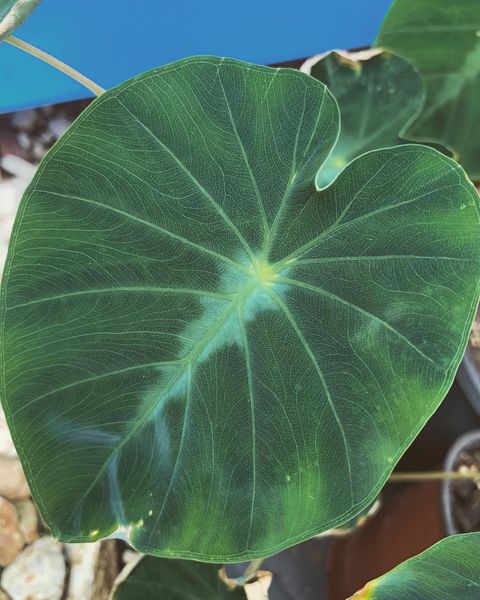
The stems are thick, up to five feet long. The leaf blade resembles many types of Alocasia plants. It has a rounded oval shape with a pointed tip. The length of the leaves of an adult can reach four and a half feet. Stems form in the leaf axils, and two or three flowers can bloom on the plant simultaneously.
16. Alocasia Sinuata
Commonly known as Jewel Alocasia or Mirror Face, Alocasia Sinuata is a rare and compact plant, perfect for indoor display.
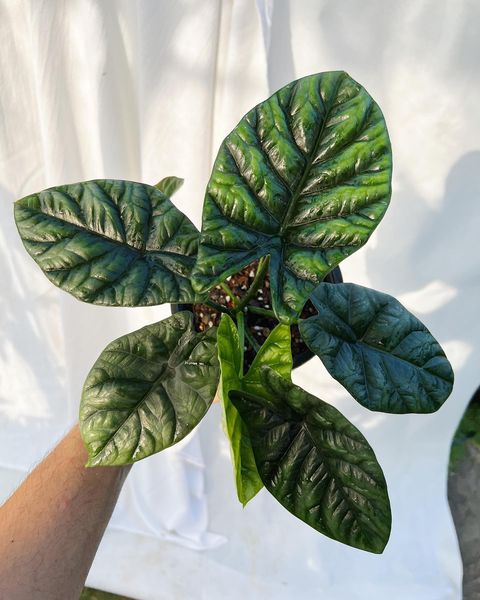
This endangered plant is native to the Philippines and exhibits lush foliage with dark green leaves, becoming the centerpiece of any garden or room.
While it shares most of its features with other stunning Jewel Alocasia varieties, its unique trait lies in the distinctive coloration, texture and foliage formation.
Alocasia Sinuata is a small-growing plant with thick and shiny leaves; young specimens start with light greenish leaves, which mature into darker green with a metallic hue and pronounced dark green veins. It carries the name Alocasia sinuata due to its wavy (sinuate) margins, ironically poorly expressed.
17. Alocasia Odora (Night-Scented Lily)
Alocasia Odora, or Night-Scented Lily, originating from Southeast and East Asia, is a huge plant four to eight feet high with large paddle-like deep green leaves two inches long.
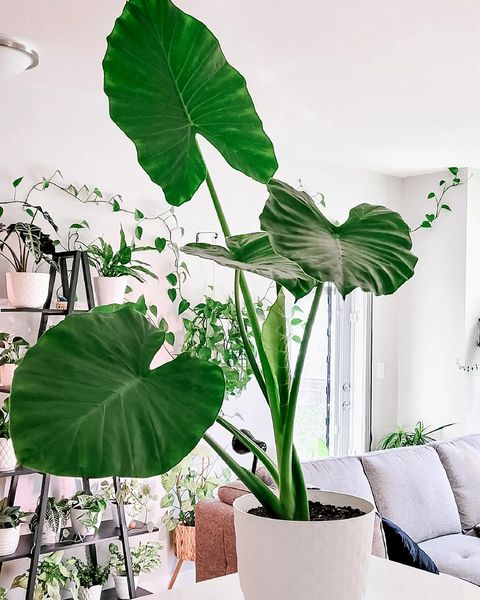
The mighty shiny green leaves stand upright on long, firm sticks, creating an irresistible jungle vibe. The young leaves are lime green, darkening as the leaves mature. The combination of bright and green fuzzy leaves at different developmental stages further emphasizes the aesthetic value of the plant.
18. Alocasia Black Velvet (Alocasia Reginula)
Alocasia reginula”Black Velvet” is a true gem among the alocasia varieties, with dark leaves resembling a jeweled deep green shade.
RELATED: Alocasia Black Velvet: An Instructive Care, Propagation, and Watering Guide
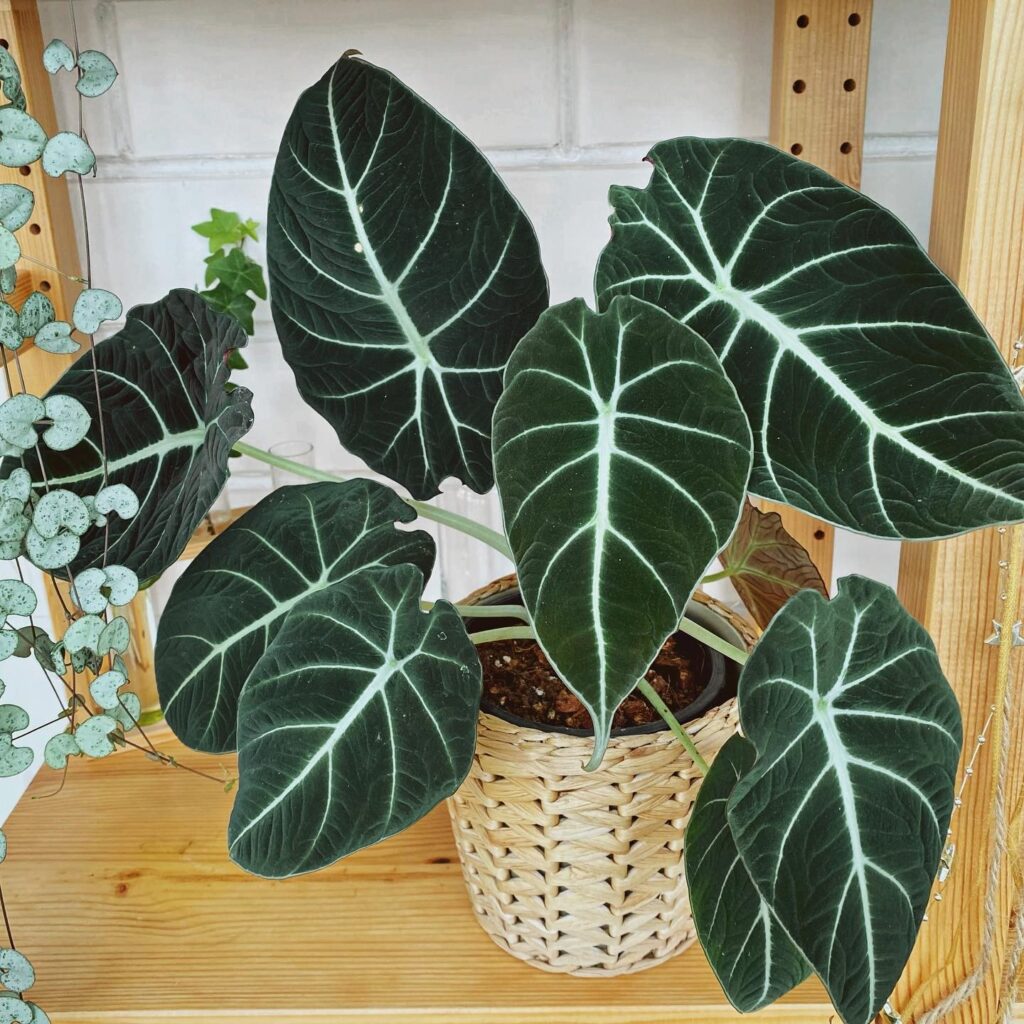
Widely recognized for its characteristic dark foliage and piercing white venations, Black Velvet Alocasia is a compact plant that quickly finds its way to the heart of any tropical plant lover and collector.
Its Latin name Alocasia Reginula in translation means little queen, suggesting the exceptional beauty of this sizable plant. Alocasia reginula “Black Velvet” arrived in our homes from distant Borneo, where it grows under the canopy of high tropical vegetation with much bright indirect light.
19. Alocasia Portei
Most of the Types Of Alocasia have large heart-shaped leaves with entire edges. However, Alocasia Portei has an entirely different leaf shape with ruffled edges. The deeply incised leaves are its trademark, making them easily distinguishable from other Alocasia plants.
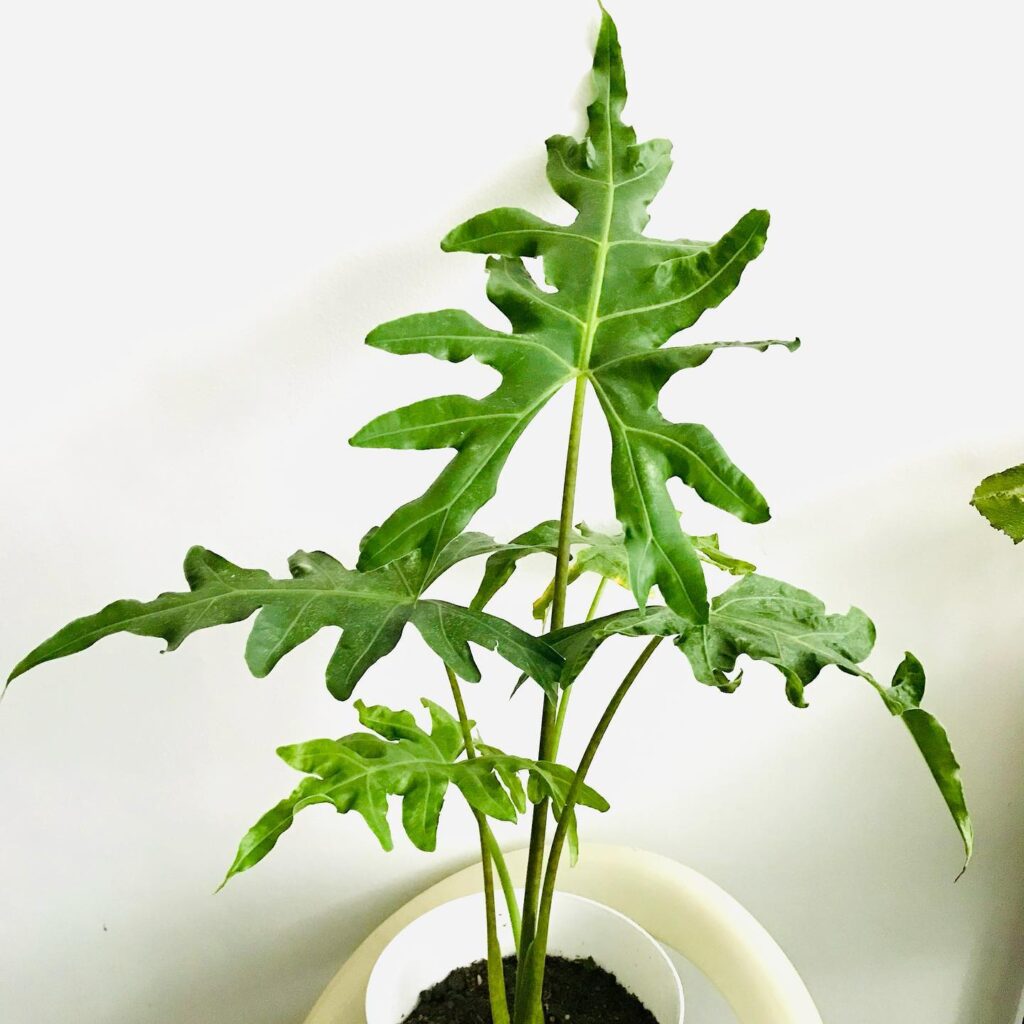
Native to the Philippines and also known as Malaysian Monster, this stunning plant can grow up to six feet tall even more so provide it with a lot of space. Its dramatic segmented light green leaves with primary green veins add to its out-of-this-world appearance.
Frequently Asked Questions
What is the rarest alocasia variety?
The rarest and most valued Alocasia is Azlanii or Red mambo due to its breathtaking dark purple leaves with pink sheen.
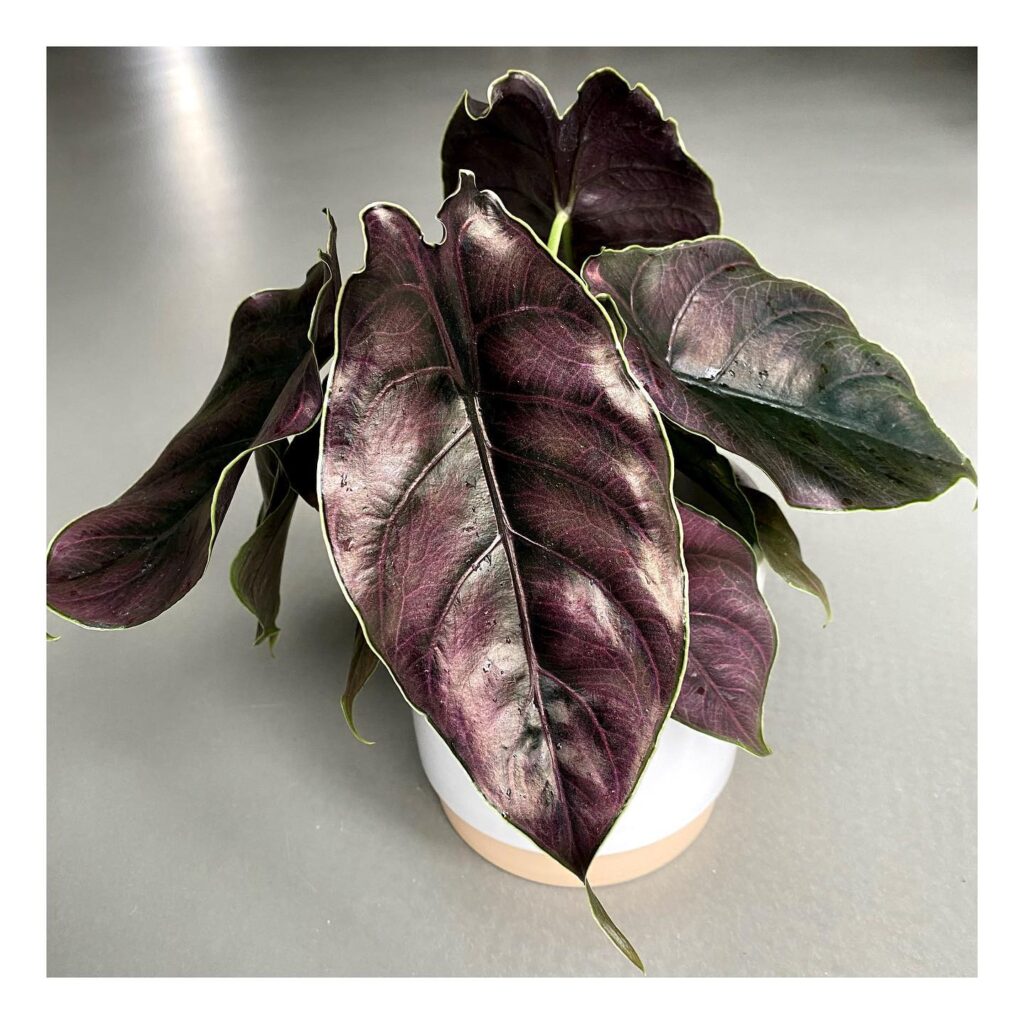
Which is the easiest Alocasia to grow?
Generally, many alocasia varieties are not demanding house plants. However, one of the easiest to grow is Alocasia amazonica polly which easily adapts to average indoor conditions.
What is the largest Alocasia plant?
The largest Alocasia plant is Giant taro, which can reach up to 15 feet in height and eight feet in width.
Is Alocasia black velvet a rare plant?
Although it is not the rarest alocasia variety, Black velvet belongs to the group of rare dwarf types of Alocasia.
Is Alocasia Polly different from Alocasia amazonica?
Alocasia polly is a smaller Alocasia amazonica with almost the same appearance.
What new types of alocasia did you discover? Also, check out out other plant facts and tips:
5 Breath-taking Types Of Calathea For Your Private Tropic Corner
Watermelon Peperomia: The Best Steps For Successful Propagation
Dying Money Tree: Important Steps and Tips To Revive Your Plant







